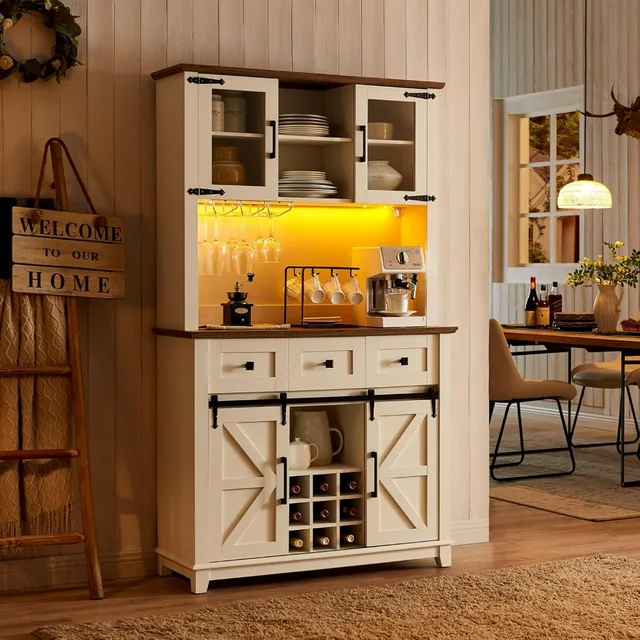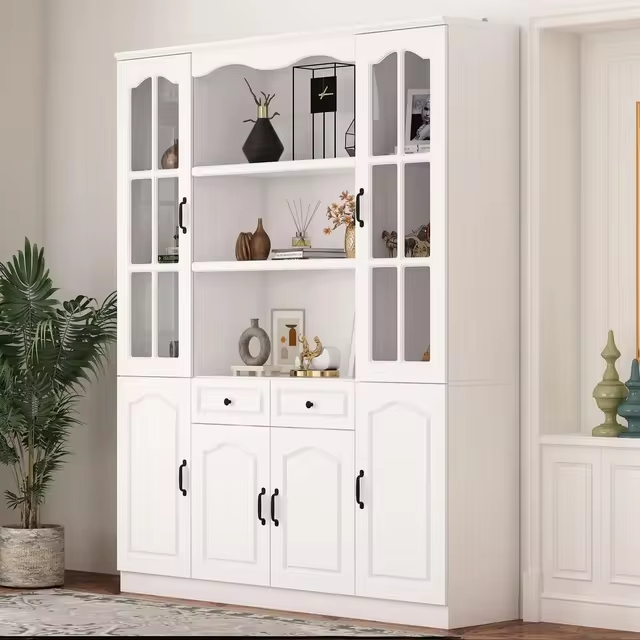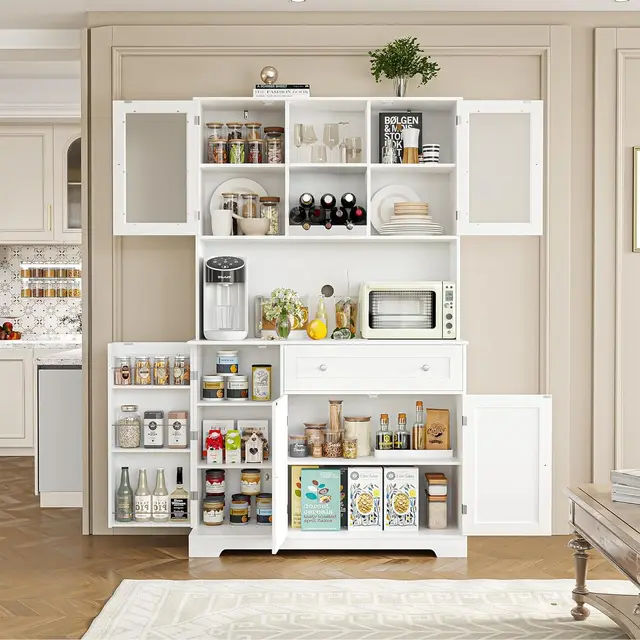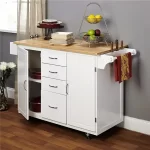The Purpose of Hutch Cabinets in Kitchen Design
Kitchen hutch cabinet serves both functional and aesthetic roles in the kitchen. These classic pieces of furniture offer a way to display fine china, glassware, or your favorite collections while also providing additional storage space. A hutch cabinet can act as a centerpiece in the kitchen, enhancing the overall decor and ambiance. It invites a sense of tradition and can also be a statement of personal style. Hutch cabinets usually come in two parts: the lower part, often featuring cupboards and drawers for storage, and the upper part, which includes shelves protected by glass doors.

Their versatility goes beyond just storage; they can help define the kitchen’s layout, adding depth and height to the room. Hutch cabinets can also fill empty wall space, turn a bare corner into a focal point, or create a sense of division in an open-plan area. For kitchens where space is at a premium, a hutch cabinet can be a space-saving solution that merges display and storage needs without compromising on style. In summary, a well-chosen kitchen hutch cabinet enhances functionality, aesthetics, and the overall feel of the kitchen.
Key Considerations Before Purchasing a Hutch Cabinet
When embarking on the quest for the ideal kitchen hutch cabinet, several key factors come into play to ensure you make a choice that’s not only stylish but practical for your needs. Here’s what to keep in mind before making your purchase:
- Assess Your Storage Needs: Take stock of the items you plan to store. A hutch with ample shelving suits dish display, while one with more drawers may better serve utensils and linens.
- Kitchen Space Measurements: Before falling in love with a hutch, measure your kitchen space. Make sure the piece fits comfortably and doesn’t impede movement or other kitchen functions.
- Design Compatibility: The hutch should complement your kitchen’s existing style. Whether it’s traditional, modern, or farmhouse, choose a design that blends seamlessly with your decor.
- Budget Considerations: Set a budget beforehand to avoid overspending. Remember, a quality hutch is an investment piece, so factor in both cost and longevity.
- Functionality Versus Aesthetics: While aesthetics are important, don’t overlook the functionality. A good hutch should strike a balance, providing both visual appeal and practical use.
- Future Proofing: Think long-term about how your needs might change. A versatile hutch can adapt to future storage requirements or design updates in your home.
Considering these aspects will guide you toward a kitchen hutch cabinet that not only looks good but also serves its purpose efficiently and stands the test of time. With these considerations in mind, your search for the perfect hutch cabinet is already on a solid foundation.
Different Styles of Kitchen Cabinets
When selecting a kitchen hutch cabinet, the style will heavily influence the room’s final look. Here are some popular styles to consider when shopping for a hutch cabinet:
- Traditional Hutches: Classic and elegant, traditional hutches often feature intricate designs and rich wood finishes, perfect for a timeless kitchen aesthetic.
- Contemporary Hutches: Sleek and minimalist, contemporary designs are great for a modern kitchen. They often have cleaner lines and less ornamentation.
- Farmhouse Hutches: Known for their rustic charm, farmhouse hutches usually combine open shelving and wood finishes, giving a cozy yet utilitarian feel.
- Country Hutches: Similar to farmhouse styles but often painted with bright colors or distressed finishes, country hutches add a quaint and homey touch.
- Transitional Hutches: These blend elements from both modern and classic styles, allowing flexibility and a balanced look.
- Industrial Hutches: Featuring metal elements and a utilitarian design, industrial hutches are a bold statement perfect for an edgy, contemporary space.
Each style serves not only as a functional storage piece but also as a decorative element that can tie in with your kitchen theme. The choice you make should echo the design language of your kitchen and your personal style while offering the practical benefits a kitchen hutch cabinet is known for. Keep in mind the ongoing theme and color palette of your kitchen to ensure your new hutch complements the existing decor.
Material Choices for Hutch Cabinets
When selecting a kitchen hutch cabinet, the material is just as important as the style. Different materials not only offer diverse looks but also vary in durability and maintenance. Here are some common materials used in hutch cabinet construction:
- Wood: The most traditional material, offering a warm, classic look with options ranging from oak, cherry, to maple.
- MDF (Medium Density Fiberboard): An affordable alternative to wood, MDF can be painted to match any decor but may lack the longevity of solid wood.
- Glass: Often used for the doors of hutch cabinets to showcase items inside. Glass needs regular cleaning but adds elegance to the piece.
- Metal: For an industrial or modern touch, metal hutches are sturdy and make a strong style statement.
- Laminate: Laminate is a budget-friendly option that comes in various colors and patterns, mimicking the appearance of real wood or stone.
- Veneer: Thin layers of wood applied over a core of MDF or particleboard, veneers offer the look of solid wood without the heftier price tag.
Selecting the right material for your kitchen hutch cabinet depends on your budget, style preference, and the level of use the hutch will endure. It’s crucial to weigh these factors to find a balance that works best for your needs and kitchen design.
Size and Space Planning for Your Kitchen Hutch
When choosing a kitchen hutch cabinet, size and space planning are crucial. Here’s how to approach this step:
- Consider the Scale: The hutch should fit well with the kitchen’s scale. A large hutch in a small kitchen can overwhelm the space. Similarly, a tiny hutch may look out of place in a spacious area.
- Measure Your Space: Accurate measurements can save you from future headaches. Measure the designated area’s height, width, and depth. Remember to consider the clearance for doors or drawers to open.
- Plan Around Traffic Flow: Place the hutch where it won’t disrupt the kitchen’s workflow. There should be enough room for people to move around comfortably.
- Visualize with Tape: Use painter’s tape to outline the hutch’s footprint on the floor. This gives a practical idea of how much space it will occupy.
- Account for Growth: If you plan to add to your collection of items to display or store, make sure there’s extra space to accommodate this growth.
- Avoid Blocking Light: Position the hutch so that it doesn’t block natural light sources. Good placement can enhance the kitchen’s open and airy feel.
- Integrate into Existing Layout: The hutch should complement the current kitchen layout. It shouldn’t look like an afterthought or a piece that interrupts the design flow.
Proper size and space planning ensure that your kitchen hutch cabinet improves functionality without compromising the kitchen’s comfort and style. With thoughtful consideration, your hutch will fit seamlessly within the space, serving as a practical and stunning addition to your kitchen.
 Additional Features and Accessories to Enhance Functionality
Additional Features and Accessories to Enhance Functionality
When choosing a kitchen hutch cabinet, consider extra features and accessories. These can greatly improve the hutch’s functionality. Here are a few options you might want to look for:
- Adjustable Shelves: Opt for hutches with adjustable shelves. This allows you to modify the space as your storage needs change.
- Built-in Lighting: Some hutches come with built-in lights. This feature showcases items within and adds warmth to the kitchen.
- Wine Racks: For wine lovers, a hutch with a built-in rack is a bonus. It keeps your collection organized and easy to access.
- Plate Grooves: If you’re displaying fine china, grooves in shelves keep plates standing and secure.
- Drawer Dividers: These help organize smaller items like cutlery or spices, keeping them tidy and within reach.
- Glass Doors: Choose hutches with glass doors to protect your items from dust while still displaying them.
Each of these features serves to make your kitchen hutch cabinet not just a storage unit but a dynamic and adaptable piece of your kitchen’s infrastructure. By selecting the right combination, you ensure your hutch serves both your present and future needs, blending seamlessly with the evolving rhythms of your household.
How to Integrate a Hutch Cabinet into Your Kitchen Decor
Integrating a kitchen hutch cabinet into your decor requires a thoughtful approach. To achieve a cohesive look, follow these guidelines:
- Match Your Decor Theme: Ensure the hutch complements your kitchen’s theme. A mismatched hutch can disrupt the visual harmony.
- Color Coordination: Pick a hutch that matches or contrasts well with your kitchen palette. It should enhance the color scheme, not clash with it.
- Use as a Focal Point: Place the hutch in a spot where it can draw attention. It can serve as a room’s centerpiece.
- Decorative Arrangement: Style the shelves with items that reflect your personality. Mix practical items with decorative pieces for balance.
- Consistent Spacing: Allow space around the hutch to prevent a cramped feel. Keep it proportional to other furniture pieces.
- Accessorize: Add personal touches, such as photos, plants, or a decorative lamp, to make the hutch feel integrated.
- Symmetry and Balance: Arrange items in a way that maintains visual balance. Group similar items together for a cohesive look.
With these tips, your hutch will not only store your items efficiently but also enhance your kitchen’s overall aesthetic.
 Care and Maintenance Tips for Hutch Cabinets
Care and Maintenance Tips for Hutch Cabinets
Maintaining your kitchen hutch cabinet is key to ensuring it looks great and lasts for years. Follow these straightforward tips to keep your hutch in top condition:
- Regular Dusting: Gently dust your hutch weekly to prevent buildup. Use a soft cloth to avoid scratching surfaces.
- Avoid Harsh Cleaners: Stick to mild detergents and avoid abrasive cleaners that can damage finishes.
- Polish Wood Surfaces: Apply wood polish occasionally to enhance the natural luster of wooden hutches.
- Glass Care: Clean glass doors with a vinegar solution or glass cleaner to keep them clear and smudge-free.
- Immediate Spill Cleanup: Wipe away spills right away to prevent stains, especially on wood.
- Check Hardware: Tighten handles and knob screws every few months to ensure they don’t come loose.
- Protect from Sunlight: Position your hutch away from direct sunlight to avoid fading and warping.
- Humidity Control: Maintain a consistent indoor humidity level to prevent wood from expanding or contracting.
By keeping these care and maintenance tips in mind, your kitchen hutch cabinet will remain a beautiful and functional piece of your kitchen decor.
Frequently Asked Questions
Addressing common questions can help you make informed decisions when selecting and using a kitchen hutch cabinet.
What Sizes Do Kitchen Hutch Cabinets Come In?
Kitchen hutch cabinets come in a variety of sizes to accommodate different kitchen layouts and storage needs. They can range from compact units designed for small kitchens to larger, more elaborate cabinets for spacious kitchens. Measure your available space and consider your storage requirements to choose the right size for your home.
Can I Customize My Kitchen Hutch Cabinet?
Yes, many kitchen hutch cabinets offer customization options. You can choose different materials, colors, finishes, and configurations to match your kitchen’s décor and meet your specific storage needs. Customizing allows you to create a hutch that perfectly fits your space and enhances the overall functionality of your kitchen.
Are There Hutch Cabinets Suitable for Modern Kitchens?
Absolutely. Modern kitchen hutch cabinets are available in sleek, minimalist designs with clean lines and contemporary materials such as glass, metal, and lacquered finishes. These cabinets are designed to complement modern kitchen aesthetics, providing both functionality and stylish appeal.
How Do I Clean and Maintain My Kitchen Hutch Cabinet?
Maintaining your kitchen hutch cabinet involves regular cleaning and proper care. Wipe down surfaces with a mild cleaner appropriate for the cabinet’s material, and avoid using harsh chemicals that could damage the finish. Organize the interior regularly to prevent clutter and ensure easy access to items. Additionally, address any spills or stains promptly to keep the cabinet looking its best.
Can a Kitchen Hutch Cabinet Improve the Value of My Home?
Yes, a well-designed and stylish kitchen hutch cabinet can enhance the overall appeal of your kitchen, making it more attractive to potential buyers. It serves as a functional and aesthetic upgrade, contributing to the home’s perceived value by showcasing efficient storage solutions and elegant design elements.
What Should I Look for When Buying a Kitchen Hutch Cabinet?
When purchasing a kitchen hutch cabinet, consider factors such as size, style, material, storage options, and your budget. Ensure the cabinet fits well within your kitchen layout, complements your existing décor, and meets your storage and display needs. Additionally, prioritize quality construction and reputable brands to ensure durability and longevity.
 Sustainable and Eco-Friendly Kitchen Cabinets
Sustainable and Eco-Friendly Kitchen Cabinets
In today’s environmentally conscious world, choosing sustainable and eco-friendly kitchen hutch cabinets is becoming increasingly important. Here are some options and considerations for environmentally friendly choices.
Reclaimed Wood Cabinets
Reclaimed wood kitchen hutch cabinets are an eco-friendly option that repurposes old wood, reducing the need for new lumber and minimizing environmental impact. These cabinets not only add character and uniqueness to your kitchen but also support sustainable practices by recycling materials.
FSC-Certified Wood
Opt for kitchen hutch cabinets made from FSC-certified wood, which ensures that the wood comes from responsibly managed forests. This certification helps protect forest ecosystems and promotes sustainable forestry practices, making it a responsible choice for environmentally conscious homeowners.
Low-VOC Finishes
Choose cabinets with low-VOC (Volatile Organic Compounds) finishes to reduce the release of harmful chemicals into the air. Low-VOC finishes are better for indoor air quality and contribute to a healthier living environment.
Sustainable Manufacturing Practices
Support brands that prioritize sustainable manufacturing practices, such as using renewable energy, reducing waste, and implementing ethical labor standards. These practices ensure that your kitchen hutch cabinet is produced in an environmentally and socially responsible manner.
Upcycling and DIY Projects
Consider upcycling an old cabinet or embarking on a DIY project to create a customized kitchen hutch cabinet. This approach not only reduces waste but also allows you to create a unique piece that perfectly fits your kitchen’s style and your personal preferences.
 Conclusion
Conclusion
In conclusion, a kitchen hutch cabinet is a versatile and elegant addition that enhances both the functionality and aesthetic of your kitchen. By understanding its benefits, styles, material options, and maintenance needs, you can choose the perfect hutch cabinet that meets your storage requirements and complements your kitchen’s design. Whether you opt for a traditional, modern, rustic, or customizable style, a kitchen hutch cabinet not only organizes your kitchen essentials but also serves as a beautiful focal point, adding charm and sophistication to your culinary space. Invest in a high-quality hutch cabinet today, and enjoy a more organized, stylish, and efficient kitchen that reflects your personal taste and enhances your home’s value.

